Are you confused when it comes to figuring out which type of thyme is best for your dishes? Look no further.
In this article, you’ll learn the difference between dried and ground thyme and how to use them in various recipes.
Armed with this knowledge, you can confidently use the right ingredient for achieving the desired flavor.

What is Dried Thyme?
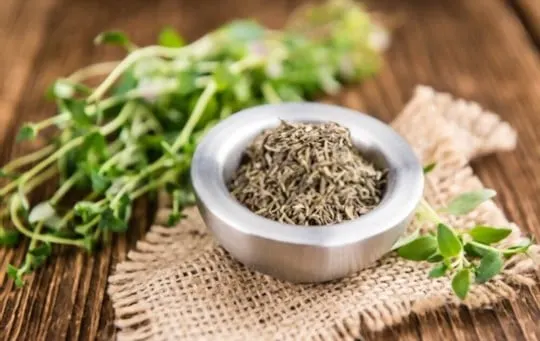
Dried thyme is a commonly used herb in cooking that comes from the Thymus vulgaris plant.
It is harvested when the leaves are mature and then dried, either by air drying or using a dehydrator.
Dried thyme has a more concentrated flavor and aroma than fresh thyme, making it ideal for recipes that require a long cooking time or where you want to add a stronger herbal note to your dish.
When it comes to using dried thyme in recipes, there are different forms available.
You can find whole leaves that have been dried, which can then be crumbled with your fingers or ground using a spice grinder.
You can also find ground thyme, which means the leaves have already been crushed into a fine powder.
As you can see, both dried and ground thyme offer similarities in terms of flavor and aroma concentration.
However, ground thyme has a finer texture and may be easier to use in some recipes where a smoother consistency is desired.
When cooking with dried thyme, it’s important to keep in mind that its potency will diminish over time.
To ensure you’re getting the best flavor possible from your herbs, store them in an airtight container away from light and heat sources.
What is Ground Thyme?
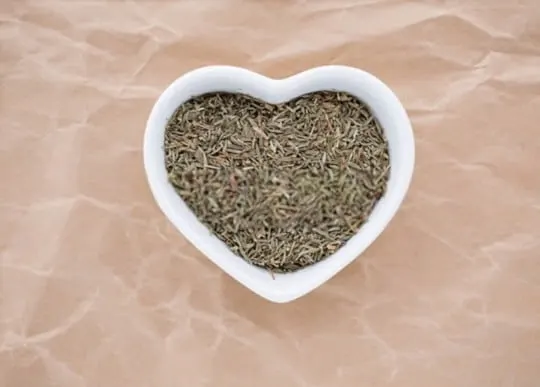
Ground thyme refers to dried thyme leaves that have been crushed or powdered into a fine form.
It is commonly used as a spice in various culinary dishes to add flavor and aroma.
Ground thyme has a unique taste, which is earthy, minty, and slightly sweet.
Ground thyme is derived from the common herb Thymus vulgaris, which is native to the Mediterranean region but also widely grown in other parts of the world.
To produce ground thyme, fresh thyme leaves are first harvested, cleaned and then left to dry until they become brittle.
The dried leaves are then grounded using a pestle and mortar or an electric grinder to produce a fine powder.
Ground thyme offers numerous benefits apart from its culinary uses.
It contains many antioxidants, which help in reducing oxidative stress linked with various diseases such as cancer and heart disease.
Additionally, it has antifungal and antibacterial properties that can enhance immune function, prevent infections, and promote overall health.
Differences Between Dried Thyme and Ground Thyme
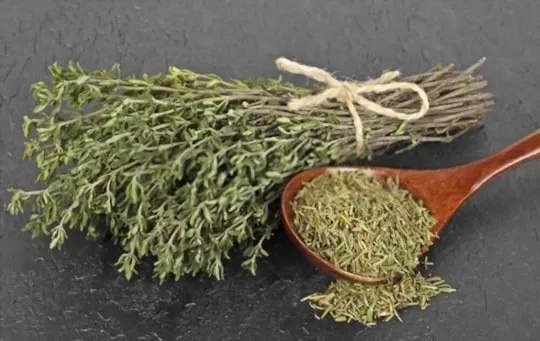
Dried thyme and ground thyme are two popular seasonings used in cooking, but they have some differences that affect their uses and flavor.
In terms of texture, dried thyme is leafy while ground thyme is finely powdered.
The texture difference affects how they mix into foods – dried thyme’s leaves may stand out visually while ground thyme blends more seamlessly into the dish.
When it comes to flavor, both types of thyme come from the same plant but differ in intensity, with ground thyme being stronger and more concentrated than dried thyme.
This means that you may need less ground thyme than dried thyme to achieve the desired flavor.
Shelf life is another area where these two types of herbs differ – dried herbs can last up to a year if stored properly while ground herbs have a shorter shelf life due to their increased surface area that exposes them to air.
Finally, application-wise, Dried Thyme is commonly used for slow-cooked dishes like roasts, soups or stews where a lower infusion rate occurs during cook-time.
On the other hand, frequently used as rubs on meat or mixed with other ingredients due to its easy dissolving or blending properties, ground thyme is preferred in such situations.
Preparation Method
To prepare dried thyme, you need to remove the leaves from the thyme plant and air dry it.
Once it is completely dry, you can store it in an airtight container for later use.
On the other hand, ground thyme requires dried thyme leaves to be grounded into fine powder form using a spice grinder or mortar and pestle.
As you can see, both types of thyme require different preparation methods to achieve their desired form.
While dried thyme retains its leafy texture, ground thyme turns into a fine powder.
When preparing either type of thyme, it is important to ensure that it is done correctly to prevent spoiling or loss of flavor.
Improperly dried or grounded thyme can lose its aroma and flavor quickly.
In summary, the preparation method for dried and ground thyme differs significantly as one requires air drying while the other involves grinding them into powder.
It is important to note that proper care must be taken when preparing herbs like these as freshness is key in getting maximum flavor in your dishes.
Texture and Appearance
When it comes to thyme, there is a noticeable difference in texture and appearance between dried and ground versions.
Dried thyme is often sold in whole leaf form, while ground thyme is finely powdered.
Additionally, dried thyme leaves have a more rough, crumbly texture compared to the soft consistency of ground thyme.
In addition to the differences listed above, dried thyme also typically retains some of its stems, which can be removed or left depending on personal preference.
On the other hand, ground thyme is completely free of any plant material aside from the fine powder itself.
Despite these variations in texture and appearance, both dried and ground thyme can be used interchangeably in many recipes.
However, it’s important to note that these differing qualities may affect cooking time or overall dish texture.
Flavor and Aroma Comparison
When it comes to cooking, the flavor and aroma of herbs play a significant role.
In this section, we will compare dried thyme and ground thyme in terms of their flavor and aroma.
As you can see, there is a notable difference between the flavors and aromas of dried thyme versus ground thyme.
Dried thyme has a milder taste compared to its ground counterpart.
Its flavor is earthy and subtle, making it perfect for use as a spice rub or seasoning for baked dishes.
On the other hand, ground thyme has a stronger flavor with hints of spiciness that can add depth to any dish when used in moderation.
When it comes to aroma, dried thyme gives off an herbal scent that is more muted compared to ground thyme.
Ground thyme’s aroma, on the other hand, has notes of both sweetness and spice that can enhance the fragrance of roasted meat or vegetables.
It’s important to note that both dried and ground thyme have similar chemical compounds that give them their distinct flavors and aromas.
However, the difference lies in how they are processed before they end up in your pantry shelf.
Uses in Cooking
Dried thyme and ground thyme are two commonly used herbs in cooking.
These two forms of thyme have their distinct uses when it comes to cooking.
Dried thyme is a favorite herb in many slow-cooked dishes such as casseroles, stews, and soups.
It has an intense flavor that can stand up to long cooking times.
When used in these dishes, the herb’s flavor becomes more pronounced as it keeps getting cooked.
Ground Thyme, on the other hand, is perfect for quick-cooking dishes since its flavor is milder compared to dried thyme.
Due to its mildness, it blends well with other herbs making it an excellent choice when you need multiple spices working together.
It’s worth noting that ground thyme works incredibly well as a seasoning for different kinds of meat since its milder taste won’t overpower the flavors of meat.
In general, using dried or ground thyme largely depends on your preference and the kind of dish you are preparing.
Both forms can be used interchangeably, but depending on what you’re making, one form may work better than the other.
When to Use Dried Thyme or Ground Thyme?
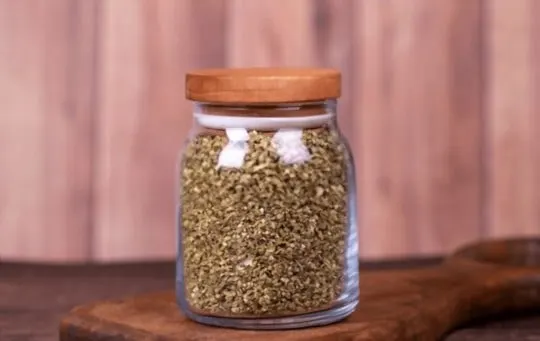
Dried thyme and ground thyme are both widely used in cooking, but the choice between the two depends on the recipe you’re making.
For recipes that require only a subtle hint of thyme flavor, such as soups, stews, and sauces, dried thyme is your best bet.
Its mild flavor adds depth without overpowering other flavors in the dish.
Moreover, it has a leafy texture that complements the overall look of the dish.
On the other hand, if you want a more pronounced and robust flavor in your recipe, such as grilled meat dishes or roasted vegetables, ground thyme is an excellent choice.
You can also use less amount of it compared to dried thyme because of its high concentration.
Furthermore, it mixes well with salt and pepper for a seasoning rub.
Lastly, remember not to substitute one for another because their taste profile and texture vary significantly.
Tips for Storing Dried Thyme and Ground Thyme
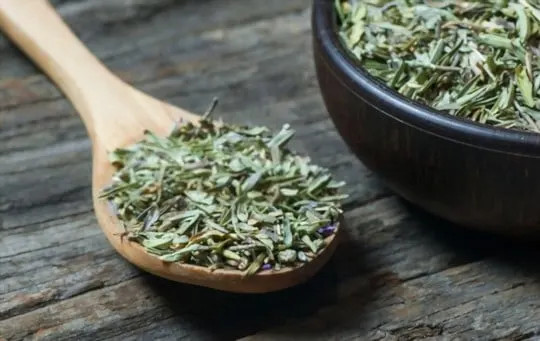
Storing dried thyme and ground thyme is essential to maintain their flavor and aroma.
When storing dried thyme, make sure to keep it in a cool, dry place away from any heat or humidity sources.
To maximize its shelf life, transfer it into an airtight container after opening the original packaging.
On the other hand, ground thyme should be stored similarly but with one key difference – avoid exposing it to light.
This means that it’s important to store it in an opaque container (or one that blocks out light).
This is because light can cause the herb’s natural compounds, which provide its flavor and aroma, to deteriorate.
Before using any of these herbs, ensure they are still fresh enough by conducting a simple freshness check.
For dried thyme this means looking for a vibrant green color whereas for ground thyme you should take a whiff of the herb – if it doesn’t have a strong aroma then it may have lost some of its potency.
By following these simple storage guidelines you can ensure that both dried and ground thyme remain flavorful and aromatic over time.
So next time you reach for either of these herbs, don’t forget that proper storage is just as important as choosing the right recipes.
Conclusion
To summarize, dried thyme and ground thyme are different in terms of texture and method of preparation.
While dried thyme leaves are air-dried, ground thyme is created by crushing the leaves into a fine powder.
Dried thyme can be used both fresh or rehydrated, while ground thyme is most effective when used uncooked.
Despite these differences, both dried and ground thyme have a similar flavor profile that makes them ideal for seasoning meat dishes, soups, sauces, and marinades.
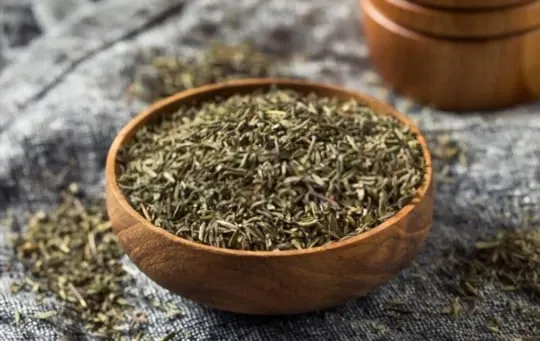
Dried Thyme vs Ground Thyme: What’s the Difference?
Ingredients
- Dried Thyme
- Ground Thyme
Instructions
- Choose between two items based on your preference and availability.
- Follow the cooking directions for your chosen option, using the appropriate ratio of ingredients.
- Prepare it according to your desired recipes.
- Incorporate them into your dish, adjusting the amount to suit your taste.
- Enjoy the unique taste experience and experiment with different dishes to explore their versatility.

Andrew Gray is a seasoned food writer and blogger with a wealth of experience in the restaurant and catering industries. With a passion for all things delicious, Andrew has honed his culinary expertise through his work as a personal chef and caterer.
His love for food led him to venture into food writing, where he has contributed to various online publications, sharing his knowledge and insights on the culinary world. As the proud owner of AmericasRestaurant.com, Andrew covers a wide range of topics, including recipes, restaurant reviews, product recommendations, and culinary tips.
Through his website, he aims to inspire and educate fellow food enthusiasts, offering a comprehensive resource for all things food-related.

Leave a comment